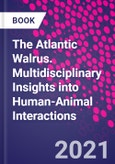The Atlantic Walrus: Multidisciplinary insights into human-animal interactions addresses the key dimensions of long-term human walrus interactions across the Atlantic Arctic and subarctic regions, over the past millennia. This book brings together research from across the social and natural sciences to explore walrus biology, human culture, environmental conditions and their reciprocal effects. Together, 13 chapters of this book reconstruct the early evolution of walruses, walrus biology, the cultural significance and ecological impact of prehistoric and indigenous hunting practices, as well as the effects of commercial hunting and international trade. This book also examines historic and ongoing management strategies and, the importance of new research methodologies in revealing hitherto unknown details of the past, and concludes by discussing the future for Atlantic walruses in the face of climate change and increased human activities in the Arctic.
This volume is an ideal resource for those who are seeking to understand an iconic Arctic species and its long and complex relationship with humans. This includes individuals and researchers with a personal or professional connection to walruses or the Arctic, as well as marine biologists, zoologists, conservationists, paleontologists, archaeologists, anthropologists, historians, indigenous communities, natural resource managers and government agencies.
Please Note: This is an On Demand product, delivery may take up to 11 working days after payment has been received.
Table of Contents
1 Introduction
Section I Atlantic walrus evolution, ecology, and behavior
2 The surprising evolutionary heritage of the Atlantic walrus as chronicled by the fossil record
3 Ecology and behavior of Atlantic walruses
4 Stocks, distribution and abundance
Section II Walruses and Indigenous peoples
5 Pre-Inuit walrus use in Arctic Canada and Greenland, c.2500 BCE to 1250 CE
6 Subsistence walrus hunting in Inuit Nunangat (Arctic Canada) and Kalaallit Nunaat (Greenland) from the 13th century CE to present
Section III European walrus use from the Norse to present
7 Early European and Greenlandic walrus hunting: Motivations, techniques and practices
8 The exploitation of walrus ivory in medieval Europe
9 Modern European commercial walrus exploitation, 1700 to 1960 CE
Section IV Future directions and innovations in Atlantic walrus research
10 Molecular advances in archaeological and biological research on Atlantic walrus
11 Atlantic walrus management, regulation and conservation
12 Anthropogenic impacts on the Atlantic walrus
13 The future of Atlantic walrus in a rapidly warming Arctic
Authors
X�nia Keighley Graduate, Globe Institute, University of Copenhagen, Denmark; Arctic Centre, University of Groningen, The Netherlands. X�nia Keighley completed her PhD as part of the Marie Curie Horizon 2020 ArchSci2020 network, investigating ancient genomics of the Atlantic walrus. She has been based at the University of Copenhagen (Denmark) and the University of Groningen (the Netherlands) and defended her PhD thesis in January 2021. X�nia's academic background is in Biology, with a Bachelor of Philosophy (Science)(Honours) awarded by the Australian National University. Her undergraduate studies focused on taxonomy, phylogeography, botany and environmental sciences. Morten Tange Olsen Associate Professor, Globe Institute, University of Copenhagen, Denmark. Morten Tange Olsen is an associate professor at the Globe Institute, University of Copenhagen, Denmark. His research seeks to document and understand the effects of environmental change, pathogens and human activities on marine mammals and ecosystems, using ancient, environmental and modern DNA analyses, museum collections and observations in the wild. He is a member of multiple marine mammal expert groups, including the Helsinki Commission (HELCOM) and the North Atlantic Marine Mammal Commission (NAMMCO), as well as the Danish Ministry of Environment and Environmental Protection Agency. Peter Jordan Professor of Archaeology, Department of Archaeology and Ancient History, Lund University, Sweden.. Peter Jordan is currently a professor of Archaeology at the Department of Archaeology and Ancient History, Lund University, Sweden. His research examines long-term human animal environment interactions in the circumpolar regions, including northern Europe and Northeast Asia. He was previously Directorof the Arctic Centre at the University of Groningen and the Netherlands Scientistin-Charge in the ArchSci2020 Network. He also served as the Netherlands representative in the Council of the International Arctic Science Committee (IASC) andwas also Chair of IASC's Polar Archaeology Network (PAN). Sean P.A. Desjardins Postdoctoral Researcher, Arctic Centre/Groningen Institute of Archaeology, University of Groningen, The Netherlands; Research Associate, Canadian Museum of Nature. Sean Desjardins is a postdoctoral researcher at the Arctic Centre and the Groningen Institute of Archaeology, University of Groningen (the Netherlands)and a research associate at the Canadian Museum of Nature (Canada). An anthropological archaeologist with more than a decade of experience investigating human walrus interactions in Inuit Nunangat (the traditional Inuit territories of Arctic Canada), his research interests include Indigenous knowledge systems, food security/food safety among hunting gathering fishing populations and
long-term human responses to climate change in the Arctic. He represents the Netherlands in the Sustainable Development Working Group (SDWG) of the Arctic Council.








